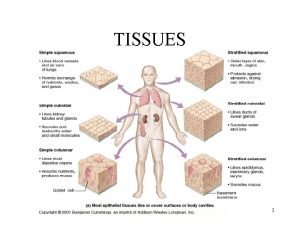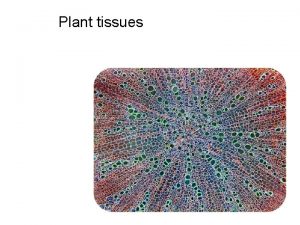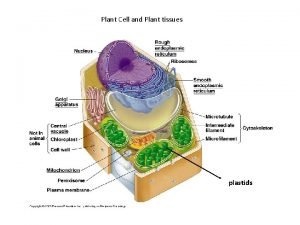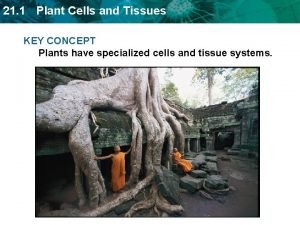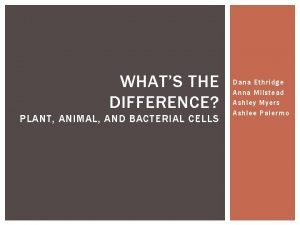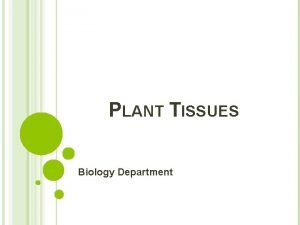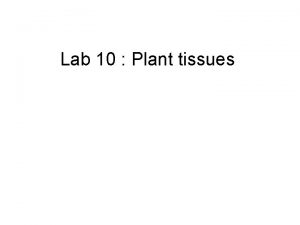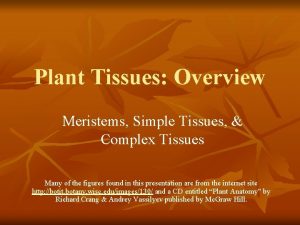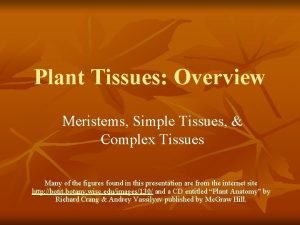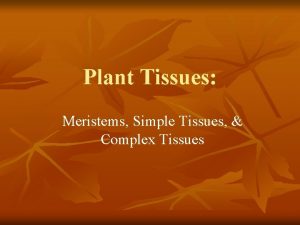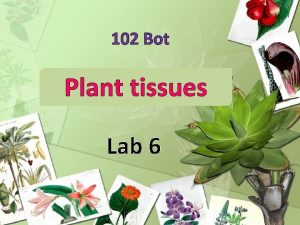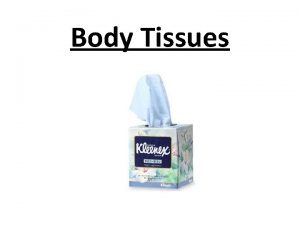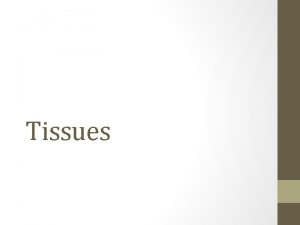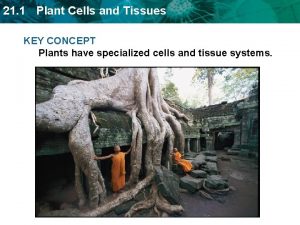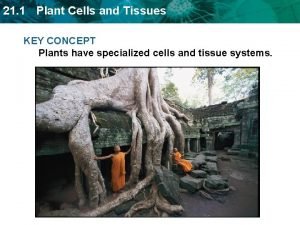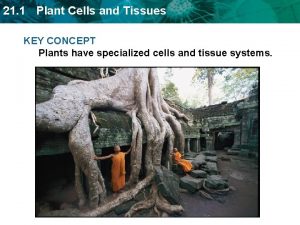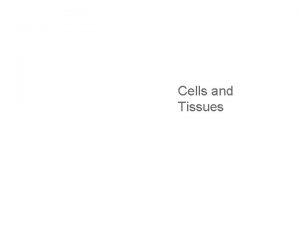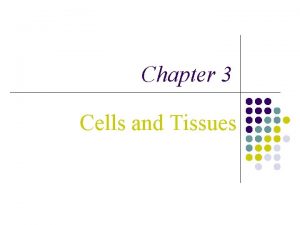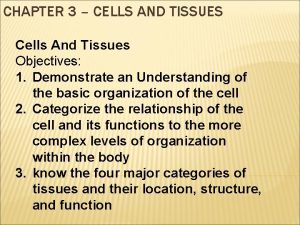21 1 Plant Cells and Tissues KEY CONCEPT























- Slides: 23

21. 1 Plant Cells and Tissues KEY CONCEPT Plants have specialized cells and tissue systems.

21. 1 Plant Cells and Tissues Plant tissues are made of three basic cell types. • Parenchyma cells are the most common plant cell type. – store starch, oils and water – help heal wounds to the plant – have thin flexible walls

21. 1 Plant Cells and Tissues • Collenchyma cells provide support to a growing plant. – they are strong and flexible. – celery strings are strands of collenchyma. – they have unevenly thick cell walls.

21. 1 Plant Cells and Tissues • Sclerenchyma cells are the strongest plant cell type. – second cell wall hardened by lignin – die when they reach maturity – used by humans to make linen and rope

21. 1 Plant Cells and Tissues Plant organs are made of three tissue systems. • Dermal tissue covers the outside of a plant. – protects the plant – secretes cuticle of leaves – forms outer bark of trees

21. 1 Plant Cells and Tissues • Ground tissue is found inside a plant. – provides support – stores materials in roots and stems – most commonly made of parenchyma

21. 1 Plant Cells and Tissues • Vascular tissue transports water, minerals and organic compounds. – two networks of hollow tubes stem – xylem transports water and minerals – phloem transports photosynthetic products leaf root

21. 1 Plant Cells and Tissues • The cohesion-tension theory explains water movement. – Plants passively transport water through the xylem. – Cohesion is the tendency of water molecules to bond with each other. – Adhesion is the tendency of water molecules to bond with other substances.

21. 1 Plant Cells and Tissues • Water travels from roots to the top of trees. – absorption occurs at roots – cohesion and adhesion in xylem – transpiration at leaves

21. 1 Plant Cells and Tissues • Transpiration is the loss of water vapor through leaves. – water vapor exits leaf stomata – helps pull water to the top branches

21. 1 Plant Cells and Tissues Roots anchor plants and absorb mineral nutrients from soil. • Roots provide many functions. – support the plant – absorb, transport, and store nutrients – root hairs help absorption

21. 1 Plant Cells and Tissues • There are several parts of a root. – root cap covers the tip – apical meristem is an area of growth – vascular cylinder contains xylem and phloem vascular cylinder apical meristem root cap

21. 1 Plant Cells and Tissues Stems support plants, transport materials, and provide storage. • Stems have many functions. – support leaves and flowers – house most of the vascular system – store water – grow underground for storage – form new plants Strawberry stolons

21. 1 Plant Cells and Tissues • Primary growth increases a plant’s length. • Secondary growth increases a plant’s width.

21. 1 Plant Cells and Tissues Most leaves share some similar structures. • The blade is usually broad and flat. – collects sunlight for photosynthesis – connects to the stem by a petiole blade petiole

21. 1 Plant Cells and Tissues • Mesophyll is between the leaf’s dermal tissue layers. cuticle upper epidermis palisade mesophyll spongy mesophyll lower epidermis

21. 1 Plant Cells and Tissues • Guard cells surround each stoma. – Stomata open and close when guard cells change shape. – When stomata are open, water evaporates and gas exchanges. – Stomata close at night and when plant loses too much water. guard cells stoma

21. 1 Plant Cells and Tissues • Leaves may be simple, compound, or double compound. Simple leaf Compound leaf Double compound leaf

21. 1 Plant Cells and Tissues • Leaf veins may be parallel or pinnate. Parallel veins Pinnate veins

21. 1 Plant Cells and Tissues • Leaf margins may be toothed, entire, or lobed. Toothed margin Entire margin Lobed margin

21. 1 Plant Cells and Tissues • Leaves have many adaptations. – for extreme temperatures, ex: pine needles

21. 1 Plant Cells and Tissues • Leaves have many adaptations. – for extreme temperatures, ex: pine needles – for water loss, ex: cactus spines

21. 1 Plant Cells and Tissues • Leaves have many adaptations. – for extreme temperatures, ex: pine needles – for water loss, ex: cactus spines – for aquatic environments, ex: water lily – for getting food, ex: Venus’ flytrap
 Body tissues chapter 3 cells and tissues
Body tissues chapter 3 cells and tissues The 4 tissues
The 4 tissues Body tissues chapter 3 cells and tissues
Body tissues chapter 3 cells and tissues Anatomy chapter 3 cells and tissues
Anatomy chapter 3 cells and tissues Eisonophil
Eisonophil Animal cell venn diagram
Animal cell venn diagram Which part of the cell contains genetic material
Which part of the cell contains genetic material Chapter 3 cells and tissues figure 3-1
Chapter 3 cells and tissues figure 3-1 Smooth endoplasmic
Smooth endoplasmic Tissues are groups of similar cells working together to
Tissues are groups of similar cells working together to Tissues are groups of similar cells working together to
Tissues are groups of similar cells working together to Divisions of anatomy
Divisions of anatomy A group of cells similar in structure and function
A group of cells similar in structure and function Procambium
Procambium 3 tissues of a plant
3 tissues of a plant Stone cells in plants
Stone cells in plants Plastid in plant cell
Plastid in plant cell Cohesion bond
Cohesion bond Paranasal sinus development
Paranasal sinus development Red blood cells and white blood cells difference
Red blood cells and white blood cells difference Masses of cells form and steal nutrients from healthy cells
Masses of cells form and steal nutrients from healthy cells Difference between bacteria and plant cell
Difference between bacteria and plant cell Animal vs plant cell venn diagram
Animal vs plant cell venn diagram Venn diagram of plant and animal cells
Venn diagram of plant and animal cells










